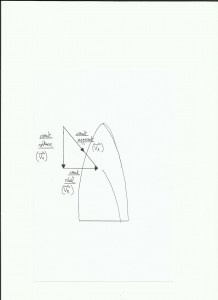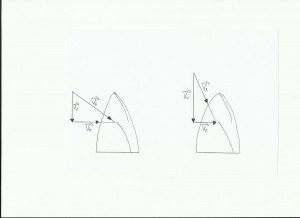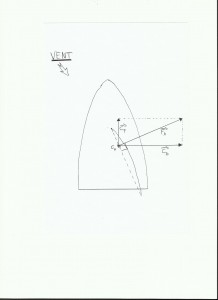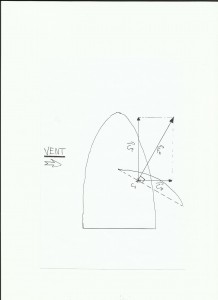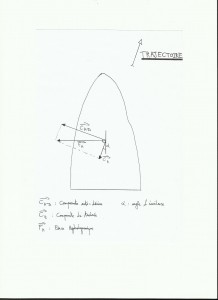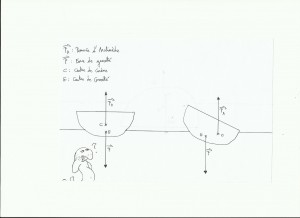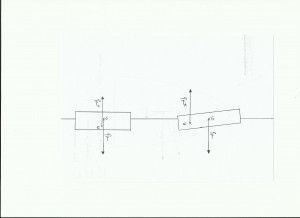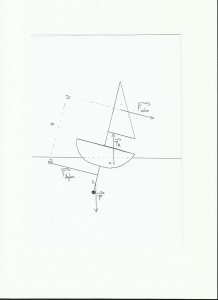The sailing boat's motor, it's the wind. However, there are several kinds of wind, relative to our position on the water. There is the geostrophic wind, found in altitude and which don't undergo friction forces(isobar lines wind), synoptic wind which undergo friction without local effects(example: squalls)and the true wind, that we perceive when we are motionless on the water. Wind perceived by the moving boat is the addition of the true wind and the wind created by the boat speed, it is the apparent wind(Va=Vr Vv).
1)The apparent wind
The apparent wind is always closer to the boat's front than the true wind, this difference can change until more than 60° at fair points of sailing(broad reach). Small drawing!
No, this is not an iron, a suppository or a rocket, this is a boat! speed wind's vector is always parallel to the boat's way, and its direction is opposite to the ship's way(this is equivalent to the wind felt when you're driving and your head is going out the window).
Changes on the true wind(rise or burst)or on the speed wind brings an apparent wind modification:
A sudden increase in the true wind moves the apparent wind away from the bow(we say that the wind is veering aft, this means that we can luff up more), in the contrary a sudden decrease in true wind moves closer the apparent wind on the bow(it is said that the wind heads, to maintain its speed we must then bear away). If the boat speed decreases(therefore the velocity vector decreases), it's veering aft; if the boat speed increases, it's heading.
Notice: this is why catamarans have generally an apparent wind sharper than on a keelboat, because of their greater speed. This is why their sails are designed differently(full batten sails, flatter and more rigid).
2)The aerodynamic force
This is the force exerted by the wind on the sails, it applies at a point considered to be the center of the sails(sailing center, corresponds to the mean "corde"), and is perpendicular to the sails. It is divided into two forces, propulsive force(parallel to the axis of the vessel) and the drift force(perpendicular to the axis of the vessel). The more we are close-hauled the more propulsive force will decrease to the detriment of drift force. The "corde" is the line that connects both ends of the sail(luff and leech).
In the case of a close-hauled sailing boat, propulsive force(Cp)is smaller than drift force(Cd). Cv is the sailing center.
In the case of a vessel, for example beam reach, this time the propulsive force will prevail.
3)The hydrodynamic force
It applies roughly on the drift center(force of the water on the hull)and’ it's the antagonist of the aerodynamic force in some way, it is perpendicular to the lubber line's boat. It is divided into two forces; the streak force parallel to the boat's trajectory , and the anti-drift force perpendicular to the streak force.
The ideal angle of incidence is 20 °. If the angle of incidence is zero, there is no hydrodynamic force, just the streak force only. The hydro force exists if: there is a fluid flow, if the boat has a speed, if there is an incident angle and an anti-drift flat.
4)Stability shape / weight
Stability is the ability of a hull to generate a righting torque against capsizing. The boat plays on two parameters for its stability, its center of buoyancy and its center of gravity(the center of buoyancy is the volumetric center of the vessel).
.Weight stability: the center of gravity is shifted relative to the axis of hull's rotation(horizontal gap).
The more distance between gravity's center and buoyancy's center is important, the more the righting torque will be high.
.Shape stability: this time it's buoyancy's center which shifts relative to the hull's rotation axis.
Notice: After a little watch on drawings we can deduce that weight stability is more relative to keelboats and shape stability is more relative to multi-hulls.
Finally, a boat with an efficient righting torque is seen as stiff.
5)Inclining torque
Inclining torque is against righting torque, it is brought by aero force, hydro force and distance(arm of lever)which separates them.
To reduce inclining torque we can reduce the aerodynamic force(reduce power by bending the mast, haul in the foot, haul in cuningham…)or reduce the distance x(by lowering the sailing center, so to take a reef). we can play on hydro force too(a canting keel allows to reduce hydro force and x distance in the same time).
